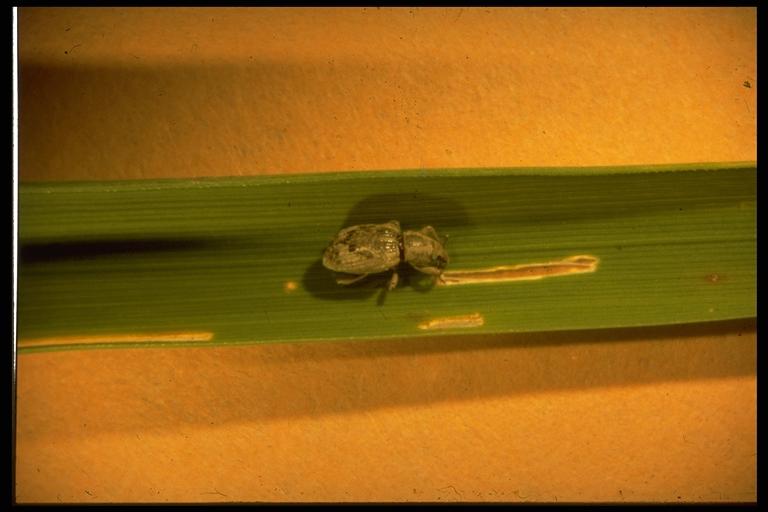
Rice water weevil, Lissorhoptrus oryzophilus Kuschel (Coleoptera: Curculionidae), adult on leaf scar. Photo by Drees.
Common Name: Rice water weevil
Scientific Name: Lissorhoptrus oryzophilus Kuschel
Order: Coleoptera
Description: Adult weevils are small (1/8 inch), grayish-black snout beetles which may have a darker brown V-shaped area on their backs.
Life Cycle: Adults spend winter hibernating (diapausing) in clump grasses, field trash and Spanish moss. Female weevils insert white eggs into leaf sheaths under water. In 4 to 9 days, tiny (1/32 inch), white, slender, legless, C-shaped larvae or grubs hatch from eggs and develop through four stages (instars) for about 27 days until they are about 1/3 inch long. They then pupate within a water-tight, oval mud cell attached to the roots and emerge 5 to 7 days later. Adults emerge throughout the reproductive stage of rice development and feed on leaves before leaving the field in late summer and fall. Development from egg to adult normally occurs within 35 days. Two generations and possibly a partial third can occur annually.
Habitat and Food Source(s): Mouthparts are for chewing. In spring (April through May), when rice plants have emerged and are being flooded, they fly into rice fields and feed on the upper layer of cells (epidermis) of leaves, producing long, narrow window-like (skeletonized) slits along the leaf called feeding “scars.” Upon reaching host plants, flight muscles of adults degenerate. Larvae chew on roots of developing rice and obtain oxygen from the host plant by means of a paired hooks on the upper surface of their second through seventh abdominal segments. Adults are most active during the evening and night. Alternate host plants include aquatic grasses and sedges that occur in and around rice fields.
Pest Status, Damage: Larval stages feed on roots of developing rice plants, causing yield reduction when they occur in large numbers; medically harmless.The root damage caused by high numbers of larvae reduces yield.
For additional information, contact your local Texas A&M AgriLife Extension Service agent or search for other state Extension offices.
Literature: Cave & Smith 1982. Drees et al. 1996. Peairs & Davidson 1956; Smith et al. 1986; Smith 1983.